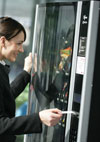

Access all areas.
For many of us, smartcards are now part of our daily lives. We rely on their technology to use transport systems, gain access into our office buildings and give us access to networked computer systems. But as smartcard technology continues to evolve, there are some interesting new applications in the pipeline.
While many of them are still at the concept phase, they have the potential to make a very real impact in the most unexpected of places.
A case in point: A South African company based near Port Elizabeth was experiencing repeated problems with theft of petrol intended for its large mining trucks. The trucks were fitted with an antenna over the petrol filler and the nozzle of the petrol dispenser was fitted with a reader module. Once the nozzle was inserted into the filler, this then enabled the petrol itself to be pumped into the trucks. However, people soon discovered that they could remove the antenna from the trucks and place it over their own car filler, which allowed them to dispense petrol directly into their own cars.
Smartcard technology specialist HID Global worked with the company to design a special, tamper-resistant antenna, which if removed from the trucks would be rendered inoperable so fuel will not be dispensed.
Another new and interesting use of smartcard technology in South Africa was found within the city government. A local authority was struggling to find an effective way of managing parking in certain areas of Cape Town where its parking attendants were vulnerable to attack when carrying money on their person.
Under a pilot scheme involving HID Global, which could be rolled out across the city if successful, motorists can purchase a city-parking card from designated retail outlets that is pre-loaded with credit. After parking, the driver locates the nearest attendant – each of whom has responsibility for monitoring a maximum of around 10 bays – and informs him of his bay number, presenting his city-parking card to a GPS-enabled mobile reader. The mobile reader verifies that there is sufficient money on that card, and when the driver selects their desired parking time, the money is deducted from the card. The reader sends an electronic message to the central station confirming that a vehicle will be parked in a particular street for a set period of time. When that time is up, a message is sent from the central station back to the mobile attendant’s reader indicating that the vehicle has outstayed its allotted time slot. The warden then can return to ticket the car if necessary.
Smartcard technology could also help to make the system of dispensing regular medicines to patients in UK hospitals more secure. One concept that is currently under investigation is storing medicine at a patient’s bedside in a secure cabinet. This cabinet is fitted with reading technology and is wirelessly connected to a piece of pharmaceutical software that can link to personal dosage information stored on an RFID wristband.
For instance, if a patient needs to take one tablet at six o’clock in the morning, the software will communicate with the cabinet to indicate that the patient needs to access their medicine. The patient then presents their wristband to the reader that is located in the cabinet, opening the drawer and allowing the patient to take their prescribed medication at the correct time. Given that the NHS already uses HID Global smartcards for physical and logical access, extending their application to dispensing of medicine is a logical progression.
Another interesting use of HID technology is to facilitate mustering. In the event of a fire drill, the usual procedure is that everybody evacuates the building and meets at an assembly point where they report to a fire warden who ticks off their name on a list. Now this manual approach is being replaced by a more sophisticated process where a company’s access control system can be used to produce a list of people in the building at the time of a fire alarm. This information is then downloaded on a regular interval to mobile or mustering devices. Once safely at the assembly point, each employee touches their secure ID card to a mobile device carried by a fire warden, and their name can be checked off, with a counter logging each person until all are accounted for. Recent tests carried out by a large London-based corporation showed that an electronic process cut the time down by 45 minutes compared to a paper one – 45 minutes that could prove vital in an emergency.
Smartcard technology is also making an appearance in the fleet management sector, with RFID now being installed in rental cars. The idea is that a hire car could be parked on the street corner and could be accessed simply by presenting an RFID-enabled card to a reader installed in the window screen. HID Global’s partners are working with some major car rental companies that are keen to leverage the benefits of this technology in streamlining the management of their fleet.
The scope for smartcard technology to improve access control and drive operational efficiencies is virtually unbounded. As we continue to search for ways to run our busy lives more safely and smoothly, it seems likely that the potential for smartcards to help us do just that will be limited only by our imagination.
For more information contact HID Global SA, +27 (0)72 923 9426, jlakin@hidglobal.com, www.hidglobal.com
| Tel: | +971 4 880 4888 |
| Email: | pacsglobalmarcom@hidglobal.com |
| www: | www.hidglobal.com |
| Articles: | More information and articles about HID |

© Technews Publishing (Pty) Ltd. | All Rights Reserved.